The vape divide: 34 countries have banned e-cigarettes entirely as the WHO says they could be just as harmful as regular tobacco – but 74 nations don’t have any rules in place
Once touted as a healthy way to quit smoking, vapes are now being banned in many countries amid fears that they are 'no better than cigarettes'.
A total of 34 countries – including Mexico, Brazil and Norway – had banned sales of the devices by July 2023, according to the World Health Organization.
And 87 – mainly in the West – had imposed restrictions on their sales, such as banning certain flavors and online sales. By 2020, 79 had passed bans.
The US – which has the largest vaping market in the world – is nowhere near a nationwide ban, but there are signs of a shift between states, with five states banning the sale of flavored e-cigarettes.
The WHO – which recently called for a ban on all flavored vapes – is calling for 'more urgent' action to curb the use of the devices. It noted that 74 countries have no rules.
But even in areas where vaping is banned, the devices – and their fruity variants – remain available due to poor enforcement.
The map above shows the countries that have banned or restricted the sale of e-cigarettes. It comes amid an international tug-of-war over the devices
According to statistics, approximately one in twenty adults – or eleven million people – use vapes in the United States.
But among teenagers and young adults, use is as high as one in four in certain age groups.
Tobacco companies claim that e-cigarettes are safer than traditional cigarettes and pose significantly fewer health risks.
But a growing body of evidence shows that the devices generate dangerous substances that damage the lungs and increase the risk of heart and lung problems.
WHO Director-General Tedros Adhanom Ghebreyesus said earlier this week: 'Children are recruited and tricked into using e-cigarettes at an early age and can become addicted to nicotine.'
“I urge countries to take strict measures to prevent adoption to protect their citizens, especially their children and young people.”
WHO's director of health promotion, Dr Ruediger Krech, added: 'E-cigarettes are targeting children through social media and influencers, with at least 16,000 flavors.
'Some of these products (even) feature cartoon characters and have sleek designs that appeal to the younger generation.'
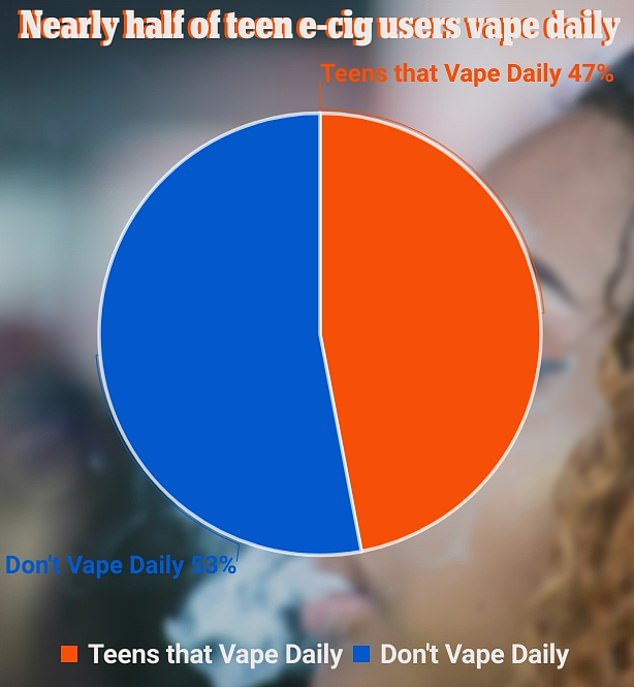
High-potency e-cigarettes are extremely addictive. Of all young people who tried one, almost half became regular users.
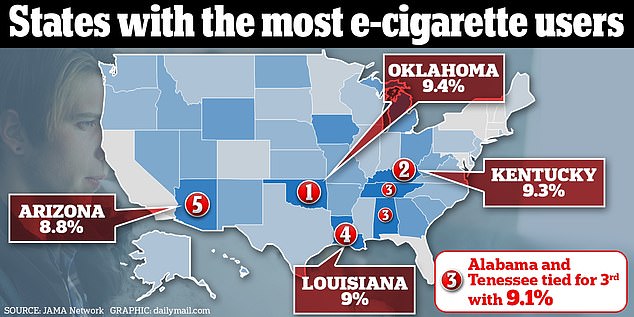
Oklahoma topped the list for the highest number of vape users in a survey released last month
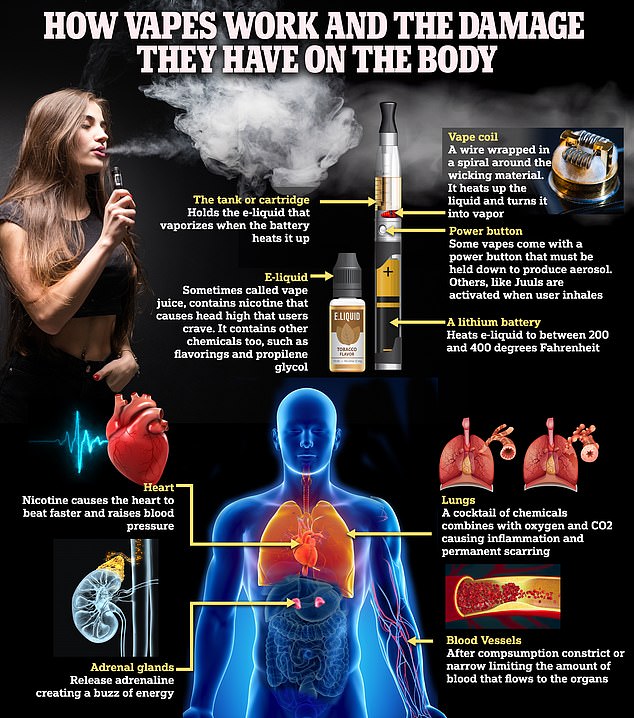
Countries are looking for the best way to regulate vaping amid their rising popularity and growing concerns about health impacts.
Many impose bans or restrictions, but a lack of enforcement makes this largely ineffective in some areas – while vapes are still available.
Over the past three years, six countries have taken steps to completely ban the sale of vapes: Cape Verde, Laos, Nicaragua, Norway, Turkey and Vanuata.
Turkey has banned the import of e-cigarettes, as well as their sale and distribution, with ruler Recep Tayyip Erdogan previously saying of vape companies: “They are getting rich by poisoning our people, we will not allow that.”
In Norway, the country has a ban on all new nicotine products coming onto the market, but the country is already trying to relax the restriction.
The Department of Health says vapes should be made available to help people quit smoking, but plans to refuse to sell the fruit and berry flavors that get people hooked.
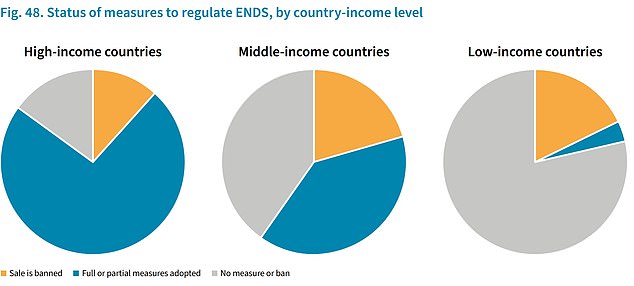
The above shows the status of e-cigarettes, or Electronic Nicotine Device Systems (ENDS), in high, middle and low income countries
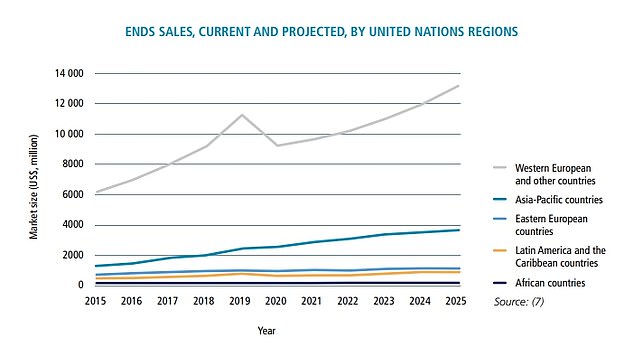
The above provides estimates for the growth of the e-cigarette market worldwide. The US falls into the gray line for 'Western European and other countries'

The above shows the share of students in grades 12, 10, and 8 who used nicotine vaping annually since 2019
In the same period, four countries have gone the other way and lifted their restrictions on vapes — Egypt, Kuwait, Bahrain and the Palestinian territories.
For Egypt, where around one in five adults smoke and is the highest smoker in the Middle East, the ban was lifted in 2022 to make vapes available to help people quit smoking.
In the US, policymakers are coming under pressure to do more to regulate e-cigarette sales in the country and their availability to children.
All e-cigarette companies are expected to seek approval from the Food and Drug Administration (FDA) before selling their products in the US.
But enforcement of this rule has been patchy at best, with flavored vapors widely available despite the FDA never approving a flavored device. The agency says it won't allow flavored vapors without “extraordinary evidence.”
Five states in the US have banned the sale of flavored vapes – California, Massachusetts, New Jersey, New York and Rhode Island – along with several cities.
The strictest ban is in San Francisco, where sales of all vaping devices were banned in 2019 in an effort to crack down on their use in the city.
Another eight states – Arkansas, Georgia, Hawaii, Maine, Oregon, South Dakota, Utah and Vermont – ban the online sale of e-cigarettes.
But many experts say more action is needed to discourage young people from picking up the habit and becoming addicted to nicotine.
Current statistics show that nearly eight percent of middle and high school students vape, or about 2.1 million children, with most using flavored devices.
A quarter of children in 12th grade admit to using the devices at least once in the past year.
This figure is down slightly, from 2.55 million in 2022, which the Centers for Disease Control and Prevention (CDC) heralded as “major progress” – but experts say much more work is needed.
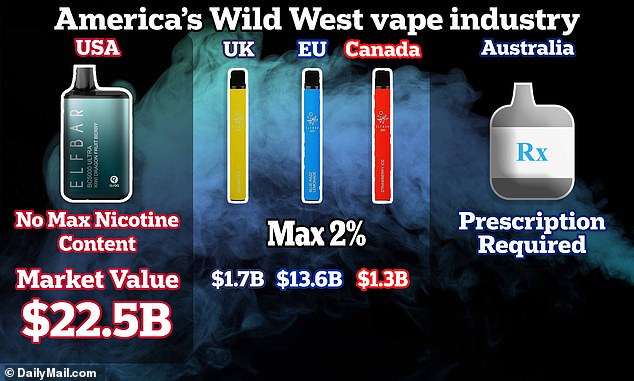
The maximum permitted nicotine content in a vapor is set at 20 milligrams of nicotine per milliliter of liquid (two percent) in Europe, the United Kingdom and Canada. These devices last approximately 550 to 600 puffs. In the US, it is quite easy to find a device or capsule that contains as much as 5 percent nicotine
